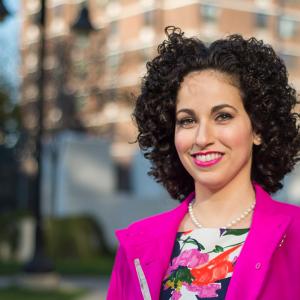
Drs. Pierre Saadeh (left) and Timothy Rapp examine a 3-D model showing the titanium plates (red) used to secure the segment of fibula (blue) that was cut to fit precisely into the gap in Sara Morales's pelvis after the tumor was excised.
Photo: Bud Glick
At first, 32-year-old Sara Morales brushed off the hip pain as strain from daily physical therapy sessions for her new knee, the result of a rare bone tumor, an osteosarcoma, above her right shin. But the throbbing grew so intense that she could no longer put weight on the affected leg. An MRI, ordered by her doctors at NYU Langone, revealed a fractured pelvis. Worse still was the cause. A new tumor was growing in her pelvic bone near the sacroiliac joint, a critical juncture of the spine and legs. “Could this really be happening again?” Morales wondered.
“Treatment for the first cancer was the worst time in my life,” she says. “To have to go through all that again? I was devastated.”
With 800 cases diagnosed each year in the U.S., osteosarcoma most often strikes children and young adults, typically during growth spurts. The cause is unknown. Morales, a petite native Lower East Sider whose brief career teaching English as a second language was interrupted by her first bout with cancer, faced a good chance for recovery. As before, treatment would consist of chemotherapy followed by removal of the diseased bone, but this time the tumor resided in a difficult location. Not only was it behind a mass of critical organs, but it was on the curve of the pelvis, which bears the weight of the leg. To fully excise the tumor, half of Morales’s pelvis might need to be removed. Morales would most likely be confined to a wheelchair for the rest of her life.
“This would be the first time part of a fibula would be inserted into a pelvis with the aid of 3-D technology,” explains Dr. Rapp, “but we didn’t see any reason why it couldn’t work.”
“I didn’t want that for Sara,” says Timothy Rapp, MD, chief of the Division of Orthopaedic Oncology, who had removed her original tumor. He had a bold idea that might allow her to walk. With help from plastic surgeon Pierre Saadeh, MD, with whom he’d devised creative solutions for other complex surgical cases, Dr. Rapp thought that if he could find a way to fill the hole in Morales’s pelvis with healthy bone, it would preserve function of her hip and leg. Dr. Rapp relied on his expertise with hard-to-reach bone tumors, and Dr. Saadeh drew on his experience saving the limbs of accident victims as chief of plastic surgery at Bellevue Hospital Center.
Facing an extremely complex operation, the surgeons could leave nothing to chance. No artery, vein, nerve, or muscle could be overlooked in the planning. When anatomy books failed to show Drs. Rapp and Saadeh the details they sought, they turned to software called BioDigital Human®, an interactive map of the human body that affords views of each organ and bone from every angle. “The pelvis is a curved bone,” explains Dr. Rapp, “so it’s much more difficult to anticipate the angles of the cuts, even if you have the best anatomical mind in the world.” While the traditional approach would be to access the pelvis through the abdomen, the surgeons determined that coming in from the back would cause less damage.
There was another challenge: figuring out how to stabilize the pelvis after removing a piece of bone measuring nearly three inches in diameter. Cutting out a chunk of bone that size would destabilize Morales’s pelvis. So the surgeons decided to take part of her fibula, the non–weight-bearing bone in the lower leg, to bridge the hole, using hardware to secure it in place. “This would be the first time part of a fibula would be inserted into a pelvis with the aid of 3-D technology,” explains Dr. Rapp, “but we didn’t see any reason why it couldn’t work.” In collaboration with a pioneer in 3-D printing technology, they used CT scans to customize plastic jigs to aid with the bone cutting. Using virtual surgery software, the surgeons practiced the procedure on a screen for hours on end.
“It all sounded so futuristic,” says Morales. “But these men had saved my life before, and I’d seen what they were capable of. I trusted them. So I said okay.”
To shrink the tumor, Morales began rigorous chemotherapy under the care of Gerald Rosen, MD, director of the Medical Oncology Sarcoma Program at NYU Langone’s Laura and Isaac Perlmutter Cancer Center. She dyed her hair in a “happy” shade of pink and settled in with her brother, Michael, for marathon sessions with Netflix—her way of dealing with the discomfort and uncertainty.
The surgery was performed at Tisch Hospital on February 2, 2015. As Dr. Rapp, a member of the Perlmutter Cancer Center, worked to remove the tumor, Dr. Saadeh carved out a piece of the fibula. “The procedure was really a technical exercise because it was all planned out in advance,” says Dr. Saadeh. The surgeons recorded the seven-hour operation so that they could present their pioneering approach at professional conferences and detail it in a peer-reviewed journal.
“Their partnership is truly state-of-the-art,” says Eduardo Rodriguez, MD, DDS, chair of the Hansjörg Wyss Department of Plastic Surgery. “The results are very remarkable—from convalescence and recovery to functional outcome.”
Last August, Dr. Rapp helped Morales onto her feet. Though weak and wobbly, she stood up, unassisted. First one crutch was put away, then the other. Morales can now walk several blocks, and she loves riding the stationary bike at the gym in anticipation of getting back on a real one this summer. “There’s so much I want to do now,” she says. “I want to get my life started and my career going and take a big trip and get married.”


